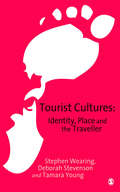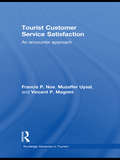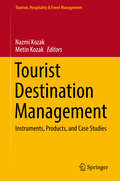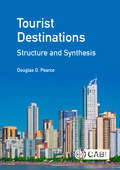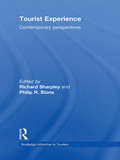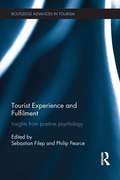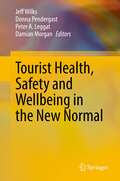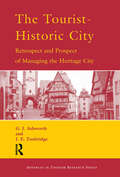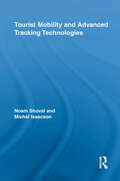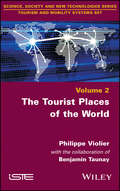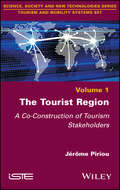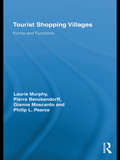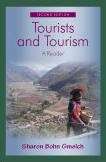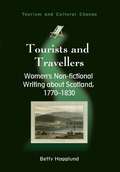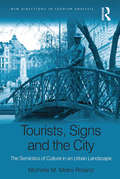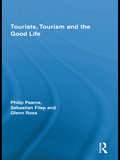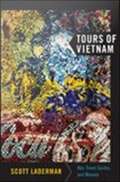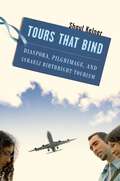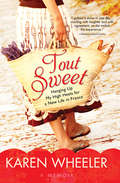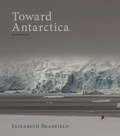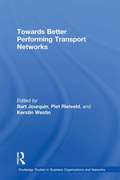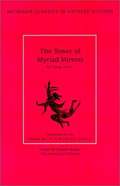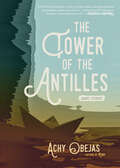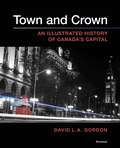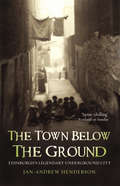- Table View
- List View
Tourist Cultures: Identity, Place and the Traveller
by Stephen Wearing Deborah Stevenson Tamara YoungSharp, engaging and relevant, Tourist Cultures presents valuable critical insights into tourism - arguing that within the imagined-real spaces of the traveller self it becomes possible to envisage tourist cultures and futures that will empower and engage.<P><P> Here is a framework for understanding tourism which is subject-centred, dynamic, and capable of dealing with the complexity of contemporary tourist cultures. <P> The book argues that tourists are not passive consumers of either destinations or their interpretations. Rather, they are actively occupied in a multi-sensory, embodied experience. It delves into what tourists are looking for when they travel, be they on a package tour, or immersing themselves in the places, cultures and lifestyles of the exotic. <P> Tourism is examined through a consideration of the spaces and selves of travel, exploring the cultures of meaning, mobilities and engagement that frame and define the tourist experience and traveller identities.<P> This book draws on the explanatory traditions of sociology, human geography and tourism studies to provide useful insights into the experiential and the lived dimensions of tourism and travel. <P> Written in an accessible and engaging style, this is a welcome contribution to the growing literature on tourism and will be important reading for students in a range of social science and humanities courses.
Tourist Customer Service Satisfaction: An Encounter Approach (Advances in Tourism)
by Francis P. Noe Muzaffer Uysal Vincent P. MagniniCustomer satisfaction and loyalty in the tourism sector is highly dependent upon the behaviours of front-line service providers. Service is about people, how they relate to one another, fulfill each other’s needs and ultimately care for each other. Yet surprisingly there are few or any books which focus on the detailed specifics of the social exchange and interaction between the service provider and customer. Tourist Customer Service Satisfaction fully explores this relationship by defining the specific kind of verbal and non-verbal messages needed for successful exchanges, outlining how the service provider ought to behave & cope in a situation as well as detailing positive approaches that enhance a service provider’s role performance. The book uses encounter theory to examine the customer – provider relationship as well as drawing on current research and theories from hospitality, tourism, management, psychology bodies of literature. In doing so the book offers important insight into how employee – centric competitive advantage in this sector can be achieved in various markets. This book is unique in its approach by focusing on the specifics of the social exchange and interaction between the service provider and customer. It therefore offers a novel synthesis of knowledge on service satisfaction in the tourism sector which will serve as valuable pedagogical and research reference for students and academics interested in hospitality and tourism.
Tourist Destination Management: Instruments, Products, and Case Studies (Tourism, Hospitality & Event Management)
by Nazmi Kozak Metin KozakThis book provides a wide-ranging overview of the current state of tourist destination management and presents important recent research in the field. Contemporary theoretical and methodological approaches to management and marketing are discussed, and innovative practices with respect to both urban and rural destinations are described with the aid of many interesting case studies from across Europe and beyond. In addition, the volume addresses key issues such as governance, cooperation, the use of social media, and sustainability. A variety of influences on tourism development are examined, and efficient strategies for making destinations distinct are explored. The book will be a welcome addition and update to the existing literature and will be of interest to academics and practitioners alike.
Tourist Destinations: Structure and Synthesis
by Douglas PearceDestinations are a central feature of tourism and the focus of much tourism research. Destinations have been studied from diverse perspectives using multiple concepts and a range of approaches. As a result, destination research today has become increasingly fragmented as studies have become more specialized. There is a need for a more integrated approach, one which systematically draws together these different research threads to provide a comprehensive and coherent picture and a fuller understanding of destinations, their structure and how they function. This book provides such a synthesis by critically reviewing a wide range of international research and incorporating in one volume many different facets of destinations from studies which have appeared in related but often divergent literatures. Conceptual and methodological issues are illustrated with empirical examples from Europe, North and South America, Asia and Oceania. This material is drawn together around two major structural themes: spatial and organizational structure. Spatial structure concerns the physical location, distribution, configuration and inter-connectedness of products, services and actors and the factors which underlie the resultant patterns of these. Organizational structure focuses on the diverse configurations and the ways in which multiple actors, collectively and individually, come together, interact and behave to produce the experiences sought by tourists. The originality and contribution of this work lies in the systematic examination and combination of these two themes across destinations from the national to the local scale. This integrated approach provides fresh insights, produces a comprehensive understanding of destinations and identifes avenues for future research.
Tourist Experience: Contemporary Perspectives (Advances in Tourism)
by Richard SharpleyTo consume tourism is to consume experiences. An understanding of the ways in which tourists experience the places and people they visit is therefore fundamental to the study of the consumption of tourism. Consequently, it is not surprising that attention has long been paid in the tourism literature to particular perspectives on the tourist experience, including demand factors, tourist motivation, typologies of tourists and issues related to authenticity, commodification, image and perception. However, as tourism has continued to expand in both scale and scope, and as tourists’ needs and expectations have become more diverse and complex in response to transformations in the dynamic socio-cultural world of tourism, so too have tourist experiences. Tourist Experience provides a focused analysis into tourist experiences that reflect their ever-increasing diversity and complexity, and their significance and meaning to tourists themselves. Written by leading international scholars, it offers new insights into emergent behaviours, motivations and sought meanings on the part of tourists based on five contemporary themes determined by current research activity in tourism experience: dark tourism experiences, experiencing poor places, sport tourism experiences, writing the tourist experience and researching tourist experiences: methodological approaches. The book critically explores these experiences from multidisciplinary perspectives and includes case studies from a wide range of geographical regions. By analyzing these contemporary tourist experiences, the book will provide further understanding of the consumption of tourism.
Tourist Experience and Fulfilment: Insights from Positive Psychology (Advances in Tourism)
by Sebastian Filep Philip PearceWhat makes life worth living? Many people would argue that it is fulfilling experiences. These experiences are characterised by feelings of joy and pleasure, positive relationships and a sense of engagement, meaning and achievement. Tourism is arguably one of the largest self-initiated commercial interventions to promote well being and happiness on the global scale but yet there is absence in the literature on the topic of fulfilling tourist experiences from psychological perspectives.Drawing on insights and theories from the research field of positive psychology (the study of well being), this is the first edited book to evaluate tourist experiences from positive psychology perspectives. The volume addresses the important topic of fulfilment through the lens of the world’s largest social global phenomenon tourism. In doing so, the book refreshes and challenges some aspects of tourist behaviour research. The chapters are grouped under three broad sections which reflect a range of positive psychological outcomes that personal holiday experiences can produce, namely; happiness and humour; meaning and self-actualisation and health and restoration. The book critically explores these fulfilling experiences from interdisciplinary perspectives and includes research studies from wide range of geographical regions. By analysing the contemporary fulfilling tourist experiences the book will provide further understanding of tourist behaviour and experience.Written by leading academics this significant volume will appeal to those interested in Tourism and Positive Psychology.
Tourist Health, Safety and Wellbeing in the New Normal
by Jeff Wilks Donna Pendergast Peter A. Leggat Damian MorganThe COVID-19 pandemic has changed the face of international and domestic tourism and sharply focused attention on the importance of tourist health, safety and wellbeing like never before. This book offers a unique perspective on the challenges facing the world’s largest service industry to protect and care for customers in a rapidly evolving environment where borders have closed, social distancing rules apply and personal hygiene has become a key focus in everyday life. Yet tourism is a very resilient industry and history shows there is always an immediate surge toward recovery after a crisis has passed. Humans want to travel and see the world. While we appreciate that the pandemic is far from over, already there are reports of pent-up demand for travel as restrictions ease at some destinations and borders begin to open. As we move hopefully toward the recovery phase and people begin to move around for business and pleasure, this book presents the reader with key information and insights in both traditional and emerging areas of tourist health, safety and wellbeing, recognising that the world is now shaped by this pandemic, bringing change, potentially enduring benefits and lasting legacies.
The Tourist-Historic City: Retrospect And Prospect Of Managing The Heritage City (Routledge Advances In Tourism Ser.)
by G.J. Ashworth J.E. TunbridgeReflects the importance of heritage to cities, and cities to the creation and marketing of heritage products, not least within tourism. This book presents a review of the state of urban heritage tourism at the turn of the twentieth and twenty-first centuries.
Tourist Mobility and Advanced Tracking Technologies (Routledge Advances in Tourism #19)
by Noam Shoval Michal IsaacsonThe remarkable developments in tracking technologies over the past decade have opened up a wealth of possibilities in terms of research into tourist spatial behaviour. To date, most research in the field has been based on data derived from less objective – hence methodologically problematic – sources. This book examines the various technologies available to track pedestrians and motorized vehicles as well as the moral, ethical and legal issues arising from the utilization of data thus obtained. The methodologies outlined in the book could prove revolutionary in terms of tourism research, management and planning.
The Tourist Places of the World
by Philippe Violier Benjamin TaunayFormerly a largely Western practice, "leisure travel" is today the most dynamic industry in the world in terms of growth. Developments in transport and communication systems mean tourism is now an integral part of our understanding of the world, and involved in the exponential increase of links between societies and different cultures. The Tourist Places of the World has comprehensive data on the number of international visitors annually. It also includes an original map ? not dictated by country, but by major tourist areas and places. The hierarchy of destinations drawn is highlighted by the different levels of popularity and passenger flows; from the universal places where all societies meet to the still unfrequented places. Beyond the recognition of global tourism, the challenge is to understand how and why societies can achieve a better life through sustainable development, which encompasses social, economic and environmental dimensions.
The Tourist Region: A Co-Construction of Tourism Stakeholders
by Jerome PiriouIn geography, a region is one of the most obscure and controversial scientific research objects. However, the tourism sector frequently uses the term, both in the communication of tourism destinations and in daily-life vocabulary, to characterize spatial practices that overtake the scale of a place. That said, a geographic concentration of place, equipment and accommodation does not equate to a tourist region. <P><P> In order to define the tourist region, this book presents the common thoughts and interpretations of it, which have been advanced by geographers since the beginning of the 20th Century. The Tourist Region also examines stakeholders' logics that are identified in the practices of a tourist destination in a regional dimension, and explores the tourist region as a territorial co-construction. Finally, this book analyzes multi-level regional networks of tourist places, built according to tourist mobilities. <P><P> By presenting several measurement methods of the tourist region, this book explains the spatial practices of tourists and anticipates the actions for tourism professionals.
Tourist Shopping Villages: Forms and Functions (Routledge Advances in Tourism)
by Laurie Murphy Pierre Benckendorff Gianna Moscardo Philip L. PearceShopping is perhaps the most universal of tourist activities. Tourists form a separate retailing segment from the general population and place importance on different products and product attributes, contributing billions of dollars each year for both the private and public sector by which retail areas, townscapes and streetscapes can be revitalised. This volume – based on a two year research program from a team of authors – examines the forms and functions of approximately fifty tourist shopping villages in Australia, New Zealand, the United Kingdom, Ireland, Canada and the United States. It will interest scholars of Tourism, Geography, Business, and Economics, as well as government officials, civic leaders, and individual entrepreneurs and retailers seeking to maximize their returns and local community residents.
Tourists and Tourism: A Reader (2nd Edition)
by Sharon Bohn GmelchThe impact of global tourism research is evident throughout this meticulously edited collection. Embedded within a logical division of topics by thematic sections are over two dozen readings including nine brand new offerings by experienced international specialists in a range of disciplines. The globally diverse articles represent a generous mix of both foundational works as well as pieces that spotlight the latest ideas and issues in the growing field.
Tourists and Travellers
by Betty HagglundDuring the late 18th and early 19th centuries, travel and tourism in Scotland changed radically, from a time when there were very few travellers and no provision for those that there were, through to Scotland's emergence as a fully fledged tourist destination with the necessary physical and economic infrastructure. As the experience of travelling in Scotland changed, so too did the ways in which travellers wrote about their experiences. Tourists and Travellers explores the changing nature of travel and of travel writing in and about Scotland, focusing on the writings of five women - Sarah Murray, Anne Grant, Dorothy Wordsworth, Sarah Hazlitt and the anonymous female author of A Journey to the Highlands of Scotland. It further examines the specific ways in which those women represented themselves and their travels and looks at the relationship of gender to travel writing, relating that to issues of production and reception as well as to questions of discourse.
Tourists, Signs and the City: The Semiotics of Culture in an Urban Landscape (New Directions in Tourism Analysis)
by Michelle M. Metro-RolandDrawing upon the literature of landscape geography, tourism studies, cultural studies, visual studies and philosophy, this book offers a multi-disciplinary approach to understanding the interaction between urban environments and tourists. This is a necessary prerequisite for cities as they make themselves into enticing destinations and compete for tourists' attention. It argues that tourists make sense of, and draw meaningful conclusions about, the places in which they tour based upon the interpretation of the signs or elements encountered within the built environment, elements such as graffiti and lamp posts. The writings of the American pragmatist Charles S. Peirce on interpretation provide the theoretical model for explaining the way in which mind and world, or thoughts and objects, result in tourists interacting with place. This theoretical framework elucidates three applied studies undertaken with foreign visitors to the Hungarian capital of Budapest. Based upon extensive ethnographic field work, these studies focus on tourists' interpretation of the urban landscape, with particular attention paid to the encounters with national culture, the role of architecture and the importance of the prosaic in urban tourism.
Tourists, Tourism and the Good Life (Routledge Advances in Tourism)
by Philip Pearce Sebastian Filep Glenn RossTourism is arguably one of the largest self-initiated commercial interventions to create well-being and happiness on the entire planet. Yet there is a lack of specific attention to the ways in which we can better understand and evaluate the relationship between well-being and travel. The recent surge of scholarly work in positive psychology concerned with human well-being and flourishing represents a contemporary force with the potential to embellish and augment much current tourism study. This book maps out the field and then draws links between tourists, tourism and positive psychology. It discusses topics such as the issue of excess materialism and its fragile relationship with well-being, the value of positive psychology to lifestyle businesses, and the insights of the research field to spa and wellness tourism. This volume will interest those who study and practise tourism as well as scholars and graduate students in a range of disciplines such as psychology, sociology, business and leisure.
Tours of Vietnam: War, Travel Guides, and Memory
by Scott LadermanIn Tours of Vietnam, Scott Laderman demonstrates how tourist literature has shaped Americans' understanding of Vietnam and projections of United States power since the mid-twentieth century. Laderman analyzes portrayals of Vietnam's land, history, culture, economy, and people in travel narratives, U. S. military guides, and tourist guidebooks, pamphlets, and brochures. Whether implying that Vietnamese women were in need of saving by "manly" American military power or celebrating the neoliberal reforms Vietnam implemented in the 1980s, ostensibly neutral guides have repeatedly represented events, particularly those related to the Vietnam War, in ways that favor the global ambitions of the United States. Tracing a history of ideological assertions embedded in travel discourse, Laderman analyzes the use of tourism in the Republic of Vietnam as a form of Cold War cultural diplomacy by a fledgling state that, according to one pamphlet published by the Vietnamese tourism authorities, was joining the "family of free nations. " He chronicles the evolution of the Defense Department pocket guides to Vietnam, the first of which, published in 1963, promoted military service in Southeast Asia by touting the exciting opportunities offered by Vietnam to sightsee, swim, hunt, and water-ski. Laderman points out that, despite historians' ongoing and well-documented uncertainty about the facts of the 1968 "Hue Massacre" during the National Liberation Front's occupation of the former imperial capital, the incident often appears in English-language guidebooks as a settled narrative of revolutionary Vietnamese atrocity. And turning to the War Remnants Museum in Ho Chi Minh City, he notes that, while most contemporary accounts concede that the United States perpetrated gruesome acts of violence in Vietnam, many tourists and travel writers still dismiss the museum's display of that record as little more than "propaganda. "
Tours That Bind: Diaspora, Pilgrimage, and Israeli Birthright Tourism
by Shaul KelnerSince 1999 hundreds of thousands of young American Jews have visited Israel on an all-expense-paid 10-day pilgrimage-tour known as Birthright Israel. The most elaborate of the state-supported homeland tours that are cropping up all over the world, this tour seeks to foster in the American Jewish diaspora a lifelong sense of attachment to Israel based on ethnic and political solidarity. Over a half-billion dollars (and counting) has been spent cultivating this attachment, and despite 9/11 and the ongoing Israeli-Palestinian conflict the tours are still going strong.Based on over seven years of first-hand observation in modern day Israel, Shaul Kelner provides an on-the-ground look at this hotly debated and widely emulated use of tourism to forge transnational ties. We ride the bus, attend speeches with the Prime Minister, hang out in the hotel bar, and get a fresh feel for young American Jewish identity and contemporary Israel. We see how tourism's dynamism coupled with the vibrant human agency of the individual tourists inevitably complicate tour leaders' efforts to rein tourism in and bring it under control. By looking at the broader meaning of tourism, Kelner brings to light the contradictions inherent in the tours and the ways that people understandtheir relationship to place both materially and symbolically. Rich in detail, engagingly written, and sensitive to the complexities of modern travel and modern diaspora Jewishness, Tours that Bind offers a new way of thinking about tourism as a way through which people develop understandings of place, society, and self.
Tout Sweet
by Karen WheelerIn her mid-thirties, fashion editor Karen has it all: a handsome boyfriend, a fab flat in west London, and an array of gorgeus shoes. But when her boyfriend, Eric, leaves she makes an unexpected decision: to hang up her Manolos and wave good-bye to her glamorous city lifestyle to go it alone in a run-down house in rural Poitou-Charentes, central western France. Tout Sweet is the perfect read for anyone who dreams of chucking away their BlackBerry in favor of real blackberrying and downshifting to a romantic, alluring locale where new friendships–and new loves–are just some of the treasures to be found amongst life's simple pleasures.
Toward Antarctica: An Exploration
by Elizabeth Bradfield“The most original piece of travel writing about the Antarctic region I have read in years . . . Bradfield is a literary tour guide in the best sense.” —Elizabeth Leane, author of Antarctica in Fiction: Imaginative Narratives of the Far SouthA poet and a naturalist, Elizabeth Bradfield documents and examines her work as a guide on ships in Antarctica through poetry, prose, and photographs, offering an incisive insider’s vision that challenges traditional tropes of The Last Continent.Inspired by haibun, a stylistic form of Japanese poetry invented by seventeenth-century poet Matsuo Basho to chronicle his journeys in remote Japan, Bradfield uses photographs, compressed prose, and short poems to examine our relationship to remoteness, discovery, expertise, awe, labor, temporary societies, “pure” landscapes, and tourism’s service economy. Antarctica was the focus of Bradfield’s Approaching Ice, written before she had set foot on the continent; now Toward Antarctica furthers her investigation with boots on the ground. A complicated love letter, Toward Antarctica offers a unique view of one of the world’s most iconic wild places.Like having a poet’s behind-the-scenes tour of a natural history museum . . . the exquisite landscape and wildlife come into vivid view; so does the gutsy work and responsibility of being a naturalist guide.” —Alison Hawthorne Deming, author of Zoologies: On Animals and the Human Spirit
Towards better Performing Transport Networks (Routledge Studies in Business Organizations and Networks)
by Bart Jourquin Piet Rietveld Kerstin WestinThe performance of current transport systems is inadequate when viewed in terms of economic efficiency, sustainability and safety. Drawing together key an impressive list of contributors from the vast field of transportation economics including Kenneth Button, David Banister and Juan Carlos Martín, this book investigates transport systems, and covers a wide range of topics such as: airline markets congestion charging speed control. This informative book, ideal for undergraduate and postgraduate students of economics, business and industrial studies examines the tools that are necessary to effectively measure transport systems and those that are required to improve them. Utilizing advanced tools of network analysis, the contributors challenge various pieces of conventional wisdom, in particular the view that intermodal transport is more environmentally benign than road transport.
The Tower of Myriad Mirrors: A Supplement to Journey to the West
by Yüeh Tung Lin Shuen-Fu Schulz Larry J.China's most outrageous character--the magical Monkey who battles a hundred monsters--returns to the fray in this seventeenth-century sequel to the Buddhist novel Journey to the West. In The Tower of Myriad Mirrors, he defends his claim to enlightenment against a villain who induces hallucinations that take Monkey into the past, to heaven and hell, and even through a sex change. The villain turns out to be the personification of his own desires, aroused by his penetration of a female adversary's body in Journey to the West. In this, his only novel, author Tung Yueh (1620-1686), a monk and Confucian scholar, picks up the slapstick of the original tale and overlays it with Buddhist theory and bitter satire of the Ming government's capitulation to the Manchus. After a nod to Journey's storyteller format, Tung carries Monkey's quest into an evocation of shifting psychological states rarely found in premodern fiction. An important though relatively unknown link in the development of the Chinese novel and window into late Ming intellectual history, The Tower of Myriad Mirrors further rewards by being a wonderful read. Shuen-fu Lin is Professor of Chinese literature at the University of Michigan. Larry Schulz holds a Ph. D. in Chinese intellectual history from Princeton University and has published his dissertation, "Lai Chih-te and the Phenomenology of Change," and articles on traditional Chinese medicine. He is currently a senior officer at the Federal Reserve Bank of Atlanta.
The Tower of the Antilles: Short Stories
by Achy ObejasFinalist for the Pen/Faulkner Award for Fiction!Longlisted for the 2018 PEN Open Book Award and The Story Prize!Included in The Rumpus's "What to Read When You've Made it More Than Halfway Through 2017"Selected as one of Rigoberto Gonzalez's Favorite Books of 2017/Critics Pick, LA Times Jacket CopyOne of Electric Literature's Best Short Story Collections of 2017"Questions of personal and national identity percolate through the stories in Obejas's memorable short fiction collection, most of which is set in Cuba, the author's birthplace...These 10 stories show Obejas's talent, illuminating Cuban culture and the innermost lives of her characters."--Publishers Weekly"By turns searing and subtly magical, the stories in Obejas' vividly imagined collection are propelled by her characters' contradictory feelings about and unnerving experiences in Cuba...For all the human tumult and deftly sketched and reverberating historical and cultural contexts that Obejas incisively creates in these poignant, alarming tales, she also offers lyrical musings on the mysteries of the sea and the vulnerability of islands and the body. Obejas' plots are ambushing, her characters startling, her metaphors fresh, her humor caustic, and her compassion potent in these intricate and haunting stories of displacement, loss, stoicism, and realization."--Booklist"Obejas's stories demonstrate an acute understanding of being caught between two places and cultures as different as America and Cuba."--Library Journal"Achy Obejas's collection is about fictional Cuban migrants who never quite escape the land they've left."--Electric Literature"Obejas writes with gentleness, without flashy wording or gimmicks, about people trying to figure out where they belong...The language we use and the stories we tell impact the futures we can imagine, but they are also restricted by what has come before. Obejas's Cuban characters, like most Americans, have limited access to the resources they need. One gets the sense that Obejas, like the Maldivian president, thinks it is time that the world takes these systemic problems on."--Los Angeles Review of Books"Achy Obejas' superb story collection The Tower of Antilles deals with the conflicted relationships Cubans, exiles and Cuban Americans have with their homeland."--LA Times Jacket CopyThe Cubans in Achy Obejas's story collection are haunted by islands: the island they fled, the island they've created, the island they were taken to or forced from, the island they long for, the island they return to, and the island that can never be home again.In "Superman," several possible story lines emerge about a 1950s Havana sex-show superstar who disappeared as soon as the revolution triumphed. "North/South" portrays a migrant family trying to cope with separation, lives on different hemispheres, and the eventual disintegration of blood ties. "The Cola of Oblivion" follows the path of a young woman who returns to Cuba, and who inadvertently uncorks a history of accommodation and betrayal among the family members who stayed behind during the revolution. In the title story, "The Tower of the Antilles," an interrogation reveals a series of fantasies about escape and a history of futility.With language that is both generous and sensual, Obejas writes about existences beset by events beyond individual control, and poignantly captures how history and fate intrude on even the most ordinary of lives.
Town and Crown: An Illustrated History of Canada’s Capital
by David L. GordonTown and Crown is an illustrated history of the planning and development of Canada’s capital, filling a significant gap in our urban scholarship. It is the story of the transformation of the region from a subarctic wilderness portage to an attractive modern metropolis with a high quality of life. The book examines the period from 1800 to 2011 and is the first major study that covers both sides of the Ottawa River, addressing the settlement history of Aboriginal, French, and English peoples.Ottawa’s transformation was a significant Canadian achievement of the new profession of urban planning in the mid-20th century. Our national capital has the country’s most complete history of community planning and served as a gateway for important international planning ideas and designers. Town and Crown illustrates the influence of landscape architect and Olmsted protégé Frederick Todd, Chicago’s City Beautiful architect Edward Bennett, and British planner Thomas Adams. Prime Minister Mackenzie King maintained a direct interest in planning Canada’s capital for almost fifty years, choosing France’s leading urbaniste, Jacques Gréber, to plan the post-1945 redevelopment of the region.The principal research method for Town and Crown includes over sixteen years of archival studies in North America, Australia, and Europe, and interviews with key politicians, designers, and planners that supplemented the contemporary research. The narrative is supplemented by over 200 images drawn from early sketches, historical maps, plans, and archival photography to illustrate the physical transformation of Canada’s federal capital.
The Town Below the Ground: Edinburgh's Legendary Undgerground City
by Jan-Andrew HendersonBelow Scotland's capital, hidden for almost two centuries, is a metropolis whose very existence was all but forgotten. For almost 250 years, Edinburgh was surrounded by a giant defensive wall. Unable to expand the city's boundaries, the burgeoning population built over every inch of square space. And when there was no more room, they began to dig down . . . Trapped in lives of poverty and crime, these subterranean dwellers existed in darkness and misery, ignored by the chroniclers of their time. It is only in the last few years that the shocking truth has begun to emerge about the sinister underground city.
